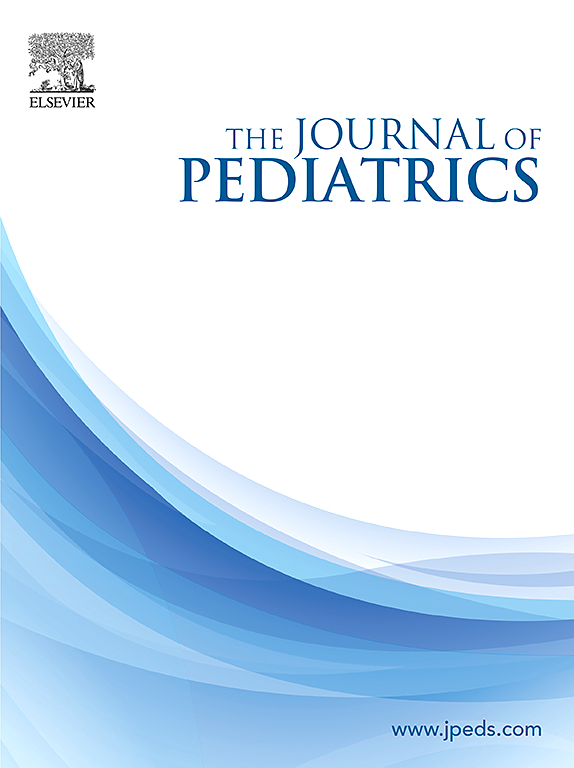Age-Related Differences in Respiratory Outcomes Among Critically Ill Children with Guillain-Barré Syndrome
IF 3.5
2区 医学
Q1 PEDIATRICS
引用次数: 0
Abstract
Objective
To evaluate age-related differences in respiratory outcomes among critically ill children with Guillain-Barré syndrome (GBS), focusing on mechanical ventilation (MV) requirements and tracheostomy placement.
Study design
This retrospective cohort study analyzed data collected prospectively within the Virtual Pediatric Systems registry (2009-2020) for US children <21 years diagnosed with GBS and admitted to an intensive care unit (ICU). The primary outcome evaluated was use of invasive mechanical ventilation (IMV). Secondary outcomes included MV duration and use of tracheostomy.
Results
Among 497 children, 185 (37.2%) required IMV, 14 (2.8%) required only noninvasive ventilation, and 45 (9.1%) received a tracheostomy. Most patients (82.7%) requiring either invasive or non-IMV received it within 24 hours of ICU admission. Compared with children ≥12 years, younger children had higher odds of requiring IMV (age <2 years: adjusted odds ratio (aOR) 3.12 [95% CI 1.37, 7.10]; age ≥2-6 years: aOR 1.87 [95% CI 1.07, 3.28]), but experienced shorter duration of ventilation (age ≥2-6 years: adjusted hazard ratio 2.37 [95% CI 1.55, 3.63]; age ≥6-12 years: adjusted hazard ratio 1.74 [95% CI 1.21, 2.50]) and had lower tracheostomy rates (age ≥2-6 years: aOR 0.21 [95% CI 0.07, 0.61]; age ≥6-12 years: aOR 0.35 [95% CI 0.12, 0.99]) when they received IMV.
Conclusions
Most children with GBS admitted to an ICU in the US do not require MV; among those who do, support is typically initiated within 24 hours of ICU admission. There are age-related variations in respiratory outcomes that may help inform clinical management.
格林-巴罗综合征危重患儿呼吸结局的年龄相关差异
目的:评估吉兰-巴罗综合征危重患儿呼吸结局的年龄相关性差异,重点关注机械通气需求和气管造口术放置。研究设计:本回顾性队列研究分析了美国儿童虚拟儿科系统注册(2009-2020)中前瞻性收集的数据。结果:497名儿童中,185名(37.2%)需要有创机械通气,14名(2.8%)只需要无创通气,45名(9.1%)接受了气管造口术。大多数需要有创或无创机械通气的患者(82.7%)在ICU入院24小时内接受了机械通气。与≥12岁的儿童相比,年龄较小的儿童需要有创机械通气的几率更高(年龄)。结论:美国ICU收治的大多数格林-巴罗综合征儿童不需要机械通气;在那些这样做的人中,支持通常在ICU入院24小时内开始。呼吸结果与年龄相关的变化可能有助于告知临床管理。
本文章由计算机程序翻译,如有差异,请以英文原文为准。
求助全文
约1分钟内获得全文
求助全文
来源期刊

Journal of Pediatrics
医学-小儿科
CiteScore
6.00
自引率
2.00%
发文量
696
审稿时长
31 days
期刊介绍:
The Journal of Pediatrics is an international peer-reviewed journal that advances pediatric research and serves as a practical guide for pediatricians who manage health and diagnose and treat disorders in infants, children, and adolescents. The Journal publishes original work based on standards of excellence and expert review. The Journal seeks to publish high quality original articles that are immediately applicable to practice (basic science, translational research, evidence-based medicine), brief clinical and laboratory case reports, medical progress, expert commentary, grand rounds, insightful editorials, “classic” physical examinations, and novel insights into clinical and academic pediatric medicine related to every aspect of child health. Published monthly since 1932, The Journal of Pediatrics continues to promote the latest developments in pediatric medicine, child health, policy, and advocacy.
Topics covered in The Journal of Pediatrics include, but are not limited to:
General Pediatrics
Pediatric Subspecialties
Adolescent Medicine
Allergy and Immunology
Cardiology
Critical Care Medicine
Developmental-Behavioral Medicine
Endocrinology
Gastroenterology
Hematology-Oncology
Infectious Diseases
Neonatal-Perinatal Medicine
Nephrology
Neurology
Emergency Medicine
Pulmonology
Rheumatology
Genetics
Ethics
Health Service Research
Pediatric Hospitalist Medicine.
 求助内容:
求助内容: 应助结果提醒方式:
应助结果提醒方式:


